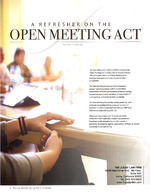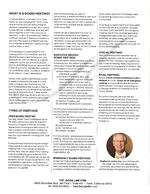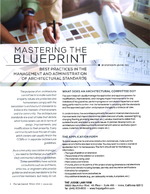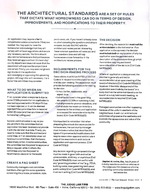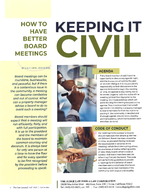An Analysis of the Factors That Determine When and How To Resolve a Trademark Dispute
 Friday, May 20, 2022 at 10:47AM
Friday, May 20, 2022 at 10:47AM A Guide to the Mediation Process
 Thursday, May 19, 2022 at 1:09PM
Thursday, May 19, 2022 at 1:09PM The Mediation: What actually happens in mediation?
The following information is provided to demystify the process and assist you in your preparation a mediation. The procedures discussed herein are those normally followed in most homeowner disputes that are mediated.
Mediation is a voluntary, non-binding process using a neutral third party to help the parties reach a mutually beneficial resolution of their dispute. A mediator helps the parties reach a resolution by facilitating communication, promoting understanding, assisting them in identifying and exploring issues, interests and possible bases for agreement, and in some matters, helping parties evaluate the likely outcome in court or arbitration if they cannot reach settlement through mediation.
Unlike a judge or an arbitrator, the mediator does not take sides or make decisions. The parties are not compelled to reach an agreement and any party is free to leave the mediation at any time. The mediator’s role is to help the parties evaluate their goals and options and find their own satisfactory solution. A settlement is not imposed upon the parties; it is reached through the facilitated negotiation process typical of a mediation proceeding.
Mediation can be described as an assisted negotiation through “shuttle diplomacy” where the mediator meets with each side separately trying to assist the parties in reaching a compromise of the dispute. The mediator is neutral and has no bias against any of the parties or their positions. However, the mediator will often act as "devil's advocate" when meeting with parties separately and use individual sessions to explore how realistic the positions of the participants are and what is possible considering the no agreement alternative.
Mediators may be requested during the mediation to assess the relative strengths and weaknesses of positions and provide an evaluation of the probable outcomes of a dispute were it to be litigated or arbitrated. Quite often, risk analysis tools are used in the evaluative process. A mediator's evaluation is simply that and nothing more; it is not binding upon the parties unless the parties agree to the contrary.
The formal procedures found in court or arbitration proceedings are not present in mediation proceedings. There are no rules of evidence or set procedures for the presentation of facts or positions.
Before mediation commences, the parties and the mediator agree upon the procedures that will be followed. It is the party's proceeding; they can fashion it in any way that makes sense to them and the mediator. This absence of formality provides for open discussion of the issues and allows the free interchange of ideas. Thus, it becomes easier to determine the interests of the parties and to fashion a solution that satisfies those interests.
The goal of mediation is for the parties to work out a solution or compromise they can live with and trust. It focuses on problem solving, not dredging up the past in the search of truth or imposing strict legal rules. The mediator is there to help the parties explore their choices and ultimately control the outcome and results, rather than having a Judge or jury decide them.
The Mediators
The mediator is an invaluable neutral resource to all participants in the mediation process. Lawyers, insurance professionals and their clients use the knowledge and skills of a neutral mediator to plan negotiation strategies and develop options for settlement. The mediator keeps the process focused and moving forward.
Neutrals, which include lawyers, former judges, psychologists, and others, are highly trained, experienced professionals. Most have received mediation training in the classroom and by observing experienced mediators in the mediation process. The parties jointly pick the neutral that they wish to use in the mediation proceeding. On occasion they will interview one or more of the neutrals before making their choice. They frequently check references before deciding on a particular neutral.
Each mediator has a unique style and the most effective mediators alter their approach to fit the unique needs and personalities of a given dispute. Facilitative mediators rely on people skills and persuasion to guide the parties toward a realm of agreement. Evaluative mediators use their experience and subject matter expertise to foresee possible outcomes and advise the parties accordingly. Each style can be used effectively and many mediators utilize a combination of both styles as the needs of the conflict dictate.
The Preliminary Meeting
In some cases, the mediator will meet with the parties and/or their representatives prior to mediation session. Usually, for the sake of convenience, a conference call substitutes for the initial meeting. This initial meeting or conference call provides:
a) An introduction to the participants and the dispute;
b) An opportunity to discuss issues affecting settlement which are important for the mediator to know in advance;
c) An opportunity to determine what information would be helpful for the mediator to have at or in advance of the mediation; and
d) An appropriate time to discuss any concerns a party might have about the mediation and his/her role in the process.
The Joint Meeting
When the mediation commences, it may begin with a joint conference among all of the parties, their counsel and the mediator.
The joint session provides an opportunity for each participant, either directly or through counsel, to express their view of the case to the other participants and how they would like to approach settlement. The opening statements are intended to begin the settlement process, not to be adversarial or a restatement of positions. This session may last anywhere from a few minutes to many hours depending on the number of participants and the complexity of the issues. Usually, the mediator will let you know in advance how to prepare for this session.
Separation of Parties
After the joint session, the parties are placed in separate rooms with their counsel and the mediator will begin “shuttle diplomacy” with private caucuses with each party. The private caucuses provide each party an opportunity to meet privately with the mediator to discuss the strengths and weaknesses of his or her position and consider new ideas for resolution and settlement. The mediator may caucus with each side just once, or several times, as needed. After the caucuses, the mediator may bring the parties back together to negotiate directly.
Sometimes, the mediator will request to speak with counsel, without the parties present.
Mediator’s Proposal
In order to bridge the gap between the parties, the mediator may suggest a settlement proposal. Unlike a proposal made by one of the parties, the mediator’s proposal is not usually rejected outright. The parties will typically caucus regarding the proposal, where they can respond to the mediator and privately accept or reject the proposal. If both parties accept, there is a settlement. If not, the parties are simply informed that no agreement has been reached so that they can retain their original bargaining positions.
Mediation Confidentiality
California law provides that all communications, negotiations, or settlement discussions by and between participants in the course of a mediation or a mediation consultation must remain confidential. Confidentiality applies to anything that was said or any admission made for the purpose of, and in the course of, a mediation or mediation consultation. Similarly, any writing “that is prepared for the purpose of, in the course of, or pursuant to a mediation or mediation consultation” is protected. There is an exemption for a written settlement agreement signed by the parties following mediation, which may be introduced and admitted into evidence if one or both sides seek to enforce it in court.
Follow Up
In some cases, telephone conferences occur following mediation sessions if no agreement has yet been reached. Sometimes, further information is required for the process to continue or additional people may need to be involved in the decision making process.
Impasse
Ultimately, the mediation will conclude when a settlement or impasse is reached. Impasse is declared when one or more parties or the mediator determines that continued negotiations would be ineffective at that time.
Agreement
The mediator will work with counsel to finalize a written settlement agreement and determine the procedures necessary for implementation. Once settlement is achieved, the mediator will make sure a written agreement is prepared for signature immediately to prevent second thoughts (“buyer’s remorse”) from destroying a good agreement. The mediator is available to provide assistance throughout the process.
Summary
If you have any questions about the mediation process, please contact Stephen M. Levine at stephenl@thejudgefirm.com

